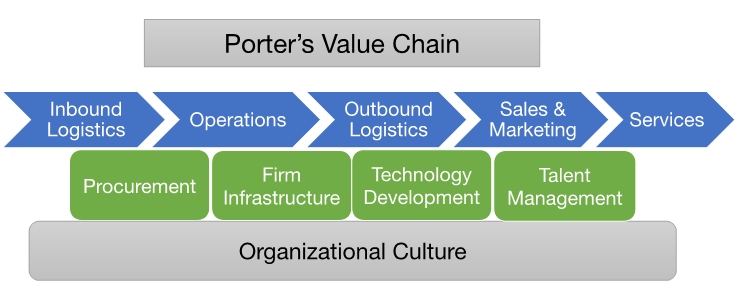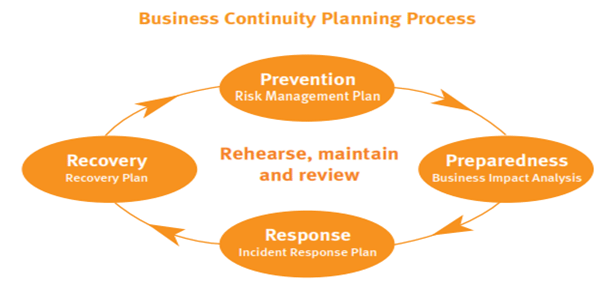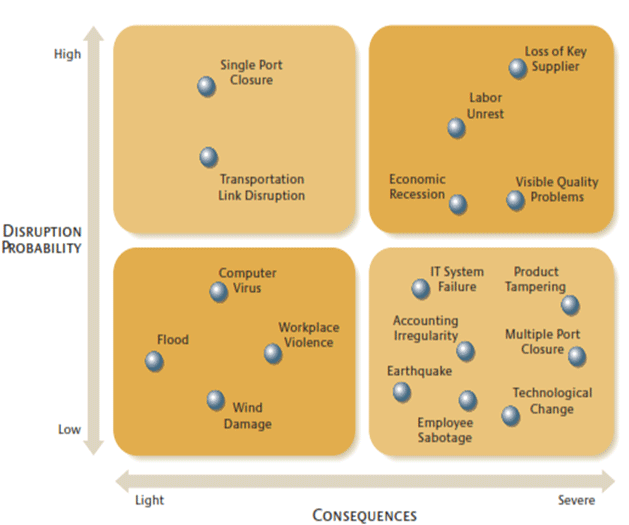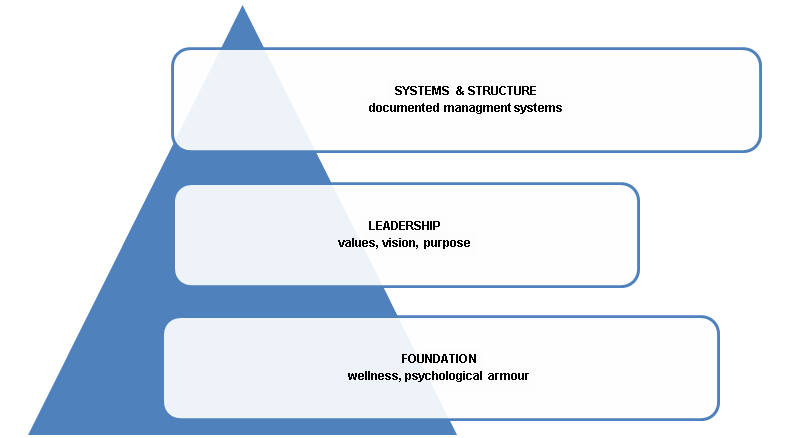Changes in demographics, technology, regulations and consumer tastes challenge organizations to improve the value proposition for their products and services, to lift productivity and bring costs down, to innovate and to seek new opportunities for growth. Added to this, exogenous events can and do severely disrupt an enterprise’s ability to deliver and sustain value creation. Organizations are therefore continually challenged to adapt, re-align and re-shape themselves in a changing context, in a manner that provides ultimate competitive advantage.
Managing, indeed surviving, in this environment requires a proactive, intuitive mind set around potential risks that can arise at any point along the value chain. Using Porter’s value chain as a template, we can see that risks abound at every point along the business processes.

For example, disruptions to inbound or outbound logistics can interrupt operations and ultimately impact the delivery of service to customers. At the same time, a break down in management controls or the loss of key personnel, can undermine the support activities and impair the organization’s ability to compete and deliver value.
Some Case Studies
The terrorist attacks of 9/11 closed US borders and played havoc with the movement of inputs and finished goods across America and the wider world. Japan’s tsunami in 2011 equally resulted in massive supply chain disruptions for companies all around the world.
Companies however are not only impacted by these cataclysmic type incidents but can also shoot themselves in the foot through internal missteps. In 2011, Eastman Kodak, after 132 years in existence and once regarded as a creative, iconic American institution, admired for its technological edge and marketing prowess, filed for bankruptcy following years of dwindling fortunes.
Kodak’s longevity is testament to its one-time ability to meet new challenges and innovate successfully, to deliver new and improved products and services over an extended period of time. However, its demise speaks to the reality that faced with the challenge of new digital technology in the 1990’s, the company failed to respond properly to change, as opposed to their rival Fujifilm that reengineered their business model and continue to prosper.
Kodak’s failure was not one of failing to react. In fact the company re-crafted its business model, invested in new research and development, slashed jobs and aggressively pursued new markets. With the benefit of hindsight, it is clear that Kodak pursued the wrong strategy. Business observers have suggested among other things a monopolistic mind-set and a culture of complacency were at the root of Kodak’s failure to act quickly and correctly.
In the same context that sees many enterprises falter, other companies are able to bounce back and indeed prosper. In March 2000, a fire at the Phillips electronics plant in New Mexico suddenly disrupted the supply of key cell phone parts to both Nokia and Erickson. For Erickson, the fallout was devastating. The company missed a key product launch and racked up massive losses, with the end result that Erickson ceased making cellular phones under its own brand. On the other hand, Nokia took a much more proactive approach, aggressively following up with Phillips on their progress in restoring their manufacturing capabilities and even sending 30 employees of their own to assist in the rebuild effort.
In Jamaica, trade liberalization and the financial sector crisis of the 1990’s led to the demise of several companies but it is significant that some organizations, notably Courts, the Gleaner newspapers and Desnoes and Geddes, reinvented themselves and still thrive today1.
Carib Cement’s reputation was severely undermined following the release of non-conforming product in 2006; yet in 2007 the Company was not only profitable but its share price rose to the highest levels ever. The company’s business was again severely disrupted following the 2008 global financial crisis. Carib Cement, which was heavily leveraged after expanding and modernizing, now found their market contracting significantly, but once more weathered a very difficult period before returning to profitability in 2014.
Most recently, the Covid-19 pandemic disrupted business on a global level, disrupting supply chains and challenging our premise as to how we work. However, once again, while this has led to the demise of some companies, others have reinvented themselves and thrived in the new paradigm.
Creating Resilient Organizations
So, how can companies better strengthen their own value chains to withstand future crises and minimize the impact of potential man-made or force of nature disasters? Research suggests that a combination of planning, flexibility and redundancy2, underpinned by a “culture of resilience”3, provides the path to true sustainability.
The ability to manage risk will be strengthened by an organization’s capability to plan and foresight, but be constrained by resources, budget, time and available information. A holistic approach to business continuity planning typically encompasses four key elements, prevention, preparedness, response and recovery (PPRR), viz.:
i. Prevention- the plans and actions taken to reduce or eliminate identified risks
ii. Preparedness- identifying the basic recovery requirements in the event of a disaster
iii. Response- the actions taken to react to an incident, and immediately thereafter, to contain, limit and de-escalate the situation.
iv. Recovery- the actions taken to resume normal business activities
It cannot be over-emphasized that business continuity planning is not an event but a process that requires continuous review and upgrade.

Source: Queensland Government (2009) Building business resilience Business Continuity Planning
Vulnerability Mapping
The planning process begins with the creation of a vulnerability framework, which allows Management to prioritize and plan intelligently for disruption. Companies can create vulnerability maps by asking themselves three key questions, viz.:
i. What can go wrong?
ii. What is the likelihood of this happening?
iii. What is the impact of such an incident?
It is important that enterprises take a broad view of potential risk that encompasses not only internal business processes and natural disasters, but also takes cognizance of the PESTLE- political, economic, social, technological, legal and environmental- context.

Source: Sheffi, Y. & Rice, J. (2005) A supply chain view of the resilient enterprise MIT Sloan Management Review
The vulnerability matrix developed provides a very visible guide to the nature and likely impact of the various risks. For example, the risk of disruption is highest in the 4th quadrant, when the likelihood and severity of a potential action are high. Organizations then use this information to avoid, reduce, transfer or retain the potential risk.
Business Continuity Strategies
Barring the issue of choosing not to continue with a specific process, organizations employ a mix of proactive and reactive strategies in managing risk across the enterprise.
Proactive strategies may include a strong occupational health, safety, security and environmental focus, supported with documented management systems to address these elements plus quality assurance, procurement, equipment reliability and disaster preparedness programs. Appropriate management controls to govern commercial transactions would also be established.
Supply chain management has become a key area for assuring business continuity. This actually begins at the design stage, adopting a terotechnological approach that builds in reliability and modular designs. It is supported by maintaining strong supplier relationships and building in redundancy by increasing safety stocks and maintaining multiple suppliers.
Building in redundancy comes at an additional cost and is tantamount to an insurance premium. Organizations also need to improve their adaptive abilities and build flexibility into their business processes. Examples of organizational agility include standardizing business processes that promote shared tacit knowledge across the organization and flexible manufacturing systems that create and then customize semi-finished products on demand.
Building a Culture of Resilience
Any organization that hopes to become resilient must overcome ideological and cognitive challenges. This often entails the challenging of past assumptions and beliefs and the bending, and often breaking, of the strategic frames that have shaped business practices in the past. Businesses need to let go of values and business models that are no longer relevant, and de-escalate commitment. Resilience also requires the ability to create new options as compelling alternatives to the prevailing failing strategies and the political will to divert resources from yesterday’s products and programs to tomorrow’s4.
The key to surviving and prospering lies in human resilience, manifested in an organizational setting as a culture of resilience. Research suggests that key organizational values that promote resilience include optimism, decisiveness, integrity and open communications. These traits are in turn nurtured by leaders with high self-esteem, belief in their own agency and who can draw on positive past experiences of overcoming adversity5.
A Model for Building Organizational Resilience
The foundation for organizational resilience is human resilience. Resilient organizations need resilient people at every level and need to invest in them. The first level of investment is in promoting employee health and wellness, providing programs to promote physical fitness, as well as strengthening their psychological armour to manage stress. However resilience also requires building the mental and emotional toughness to commit in the face of unpredictable outcomes and persist when the solution is unclear. One route to this is training employees to learn to manage their emotions and develop visualization and coping techniques to deal with adversity, while maintaining a positive and optimistic outlook.
Organizations also need to invest in developing their leaders. While research continuously shows that good leadership is an important driver for value creation many firms are guilty of not paying enough attention to this area. Leadership is an especially complex process and firms must invest in the development and mentoring of Managers to shape their behaviours and develop the core skills that front line leaders. When faced with roadblocks, Leaders need to reach into their vision, to revisit what they committed to, and find the fortitude to press on and succeed.
The human element of resilience, the fact that people are at the center of all strategy, has been deliberately emphasized. However it is equally important the employees are trained and apply best practices in the risk management, enterprise wide planning, forecasting and foresighting.

Successful organizations, which demonstrate a culture of resilience, distinguish themselves by maintaining a sharp customer focus and making an investment in developing their leaders and the wider workforce. These companies are better able to adapt in times of adversity and better positioned to flourish while others flounder.
Anthony Haynes is the Managing Director of Anthony Haynes Consulting Limited.
References:
- Lawrence, W. (2014) Business renewal and performance in Jamaica The University of the West Indies press
- Sheffi, Y. & Rice, J. (2005) A supply chain view of the resilient enterprise MIT Sloan Management Review
- Everly, G. (2011) Building a resilient organizational culture Harvard Business Review
- Sull, D. (2003) Revival of the fittest Harvard Business Press
- Hamel, G & Välikangas, L. (2003) The quest for resilience Harvard Business Review
September 2023
